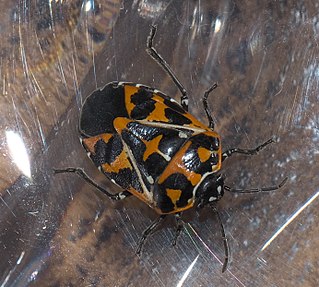Eurychoromyia mallea, the broad-headed fly, is a species of flies in the subfamily Eurychoromyiinae.

The Lauxaniidae are a family of acalyptrate flies. They generally are small flies with large compound eyes that often are brightly coloured in life, sometimes with characteristic horizontal stripes, such as in Cestrotus species. Many species have variegated patterns on their wings, but in contrast they generally do not have variegated bodies, except for genera such as Cestrotus, whose camouflage mimics lichens or the texture of granitic rocks.

The Chamaemyiidae are a small family of acalyptrate flies with less than 200 species described worldwide. The larvae of these small flies are active and predatory and are often used for biological control of aphids, scale insects, and similar pests. Chamaemyiid fossils are poorly represented in amber deposits, but a few examples are known from the Eocene epoch onwards.

Odiniidae is a small family of flies. There are only 58 described species but there are representatives in all the major biogeographic realms.

The Celyphidae, commonly known as beetle flies or beetle-backed flies, are a family of flies. About 115 species in about 9 genera are known chiefly from the Oriental and Afrotropic biogeographic regions with one lineage in the New World.

Apsilocephalidae is a family of flies in the superfamily Asiloidea. It was historically treated as a subfamily within Therevidae, but placed in a separate family in 1991, and subsequently recognized as more distantly related. The family contains three extant genera and at least five extinct genera described from the fossil record.

Tachydromiinae is a subfamily of hybotid flies widespread in the world.

Ocydromia is a genus of hybotid flies.
The broad-headed flies is a subfamily of flies. Until 2010, they were known from only one species based on four specimens and placed in the family Eurychoromyiidae.

Cestrotus is a genus of brachyceran flies in the family Lauxaniidae.

Murgantia is a genus of stink bugs in the family Pentatomidae. There are at least 12 described species in Murgantia.
Atopocelyphus is a genus of beetle flies. It is known from the Neotropical realm.
Acrometopia is a genus of flies in the family Chamaemyiidae.
Exalla is a genus of flies in the family Lauxaniidae.
Choryeuromyia xenisma is a species of flies in the subfamily Eurychoromyiinae.
Euryhendelimyia schlingeri is a species of flies in the subfamily Eurychoromyiinae.
Eurystratiomyia is a genus of flies in the family Lauxaniidae.
Physegeniopsis is a genus of flies in the family Lauxaniidae.
Echinoleucopis is a genus of flies belonging to the family Chamaemyiidae.

The second circle of hell is depicted in Dante Alighieri's 14th-century poem Inferno, the first part of the Divine Comedy. Inferno tells the story of Dante's journey through a vision of the Christian hell ordered into nine circles corresponding to classifications of sin; the second circle represents the sin of lust, where the lustful are punished by being buffeted within an endless tempest.








